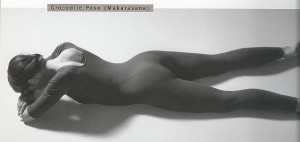Click here for guided Makarasana practice on my Youtube channel
Crocodile (Makarasana)
Crocodile pose is a centering exercise to bring our awareness from the external to the internal world. It is useful at the beginning of a longer practice or on its own as a break in your day. In addition to the calming effect, benefits include strengthening diaphragmatic breath.
(Photo Yoga, Mastering the Basics by Sandra Anderson and Rolf Sovik)
In crocodile pose, you lie face down on the floor. Cross your arms in front of you and let your palms rest on the opposite upper arms. Your elbows need to be far enough out that only your lower ribs touch the floor. If your elbows are too close to the body, the shoulders will be uncomfortable. If your elbows are too far away, the chest will be on the floor. The legs are in a V with the toes either pointed in or out, depending on comfort.
Begin with your awareness in your entire body from head to toes. As you slowly scan the body, notice how you feel. Let go of any tension or tight spots, relaxing the body systematically from the scalp to the tips of the toes. Bring your mind back up the body, being aware of the support of the floor and allowing your body to comfortably settle in.
Notice the breath at the navel center. Observe the rhythm and how the body feels as the breath flows in and out. Notice how the abdomen settles into the floor, muscles relaxing, as you exhale and the expansion on the inhalation. Don’t try to change anything, simply observe and notice how the breath changes on its own as the body relaxes and the mind focuses.
Observe the belly area for awhile then expand your awareness to include the sides of the lower ribs. Notice if they expand a bit on the inhalation. Is there any movement in the lower back? Focus on how the body feels as you breathe.
After three to five minutes, roll over onto your back and relax into shavasana. Continue to observe the movement of the body with the breath. Allow the breath to become smooth, even and without pauses, breaks or jerkiness. After a few minutes of following the breath at the navel center, bend the knees and roll over onto your left side. When you come up into sitting, be still and observe the breath in this position.
Every few hours throughout the day, take a 2 minute ‘breather’. Sit or stand straight, observe the rhythm of the breath in the navel area. Allow the breath to be diaphragmatic, smooth and even without any pauses or breaks then continue with your day.
Contact: Lynn Fraser [email protected]
